Thursday 25 April 2013
Geochronology
This is going to be a simple post for this week. Just an outline of the time periods, their names, ages and subdivisions. I hope to expand on this later but this will serve as an initial reference guide. All information is taken from the GeoWhen Database.
MYA = Million Years Ago, TYA = Thousand Years Ago
4567 MYA - Hadean
3800 MYA - Archean - Eoarchean
3600 MYA - - Paleoarchean
3200 MYA - - Mesoarchean
2800 MYA - - Neoarchean
2500 MYA - Proterozoic - Paleoproterozoic - Siderian
2300 MYA - - - Rhyacian
2050 MYA - - - Orosirian
1800 MYA - - - Statherian
1600 MYA - - Mesoproterozoic - Calymmian
1400 MYA - - - Ectasian
1200 MYA - - - Stenian
1000 MYA - - Neoproterozoic - Tonian
850 MYA - - - Cryogenian
630 MYA - - - Ediacaran
542 MYA - Phanerozoic - Paleozoic - Cambrian - Early Cambrian
513 MYA - - - - Middle Cambrian
501 MYA - - - - Late Cambrian
488 MYA - - - Ordovician - Early Ordovician - Tremadocian
478 MYA - - - - - Arenig
471 MYA - - - - Middle Ordovician - Ordovician III (No official name)
468 MYA - - - - - Darriwilian
460 MYA - - - - Late Ordovician - Ordovician V (No official name)
455 MYA - - - - - Ordovician VI (No official name)
445 MYA - - - - - Hirnantian
443 MYA - - - Silurian - Early Silurian - Llandovery - Rhuddanian
439 MYA - - - - - - Aeronian
436 MYA - - - - - - Telychian
428 MYA - - - - - Wenlock - Sheinwoodian
426 MYA - - - - - - Homerian
422 MYA - - - - Late Silurian - Ludlow - Gorstian
421 MYA - - - - - - Ludfordian
418 MYA - - - - - Pridoli
416 MYA - - - Devonian - Early Devonian - Lochkovian
411 MYA - - - - - Praghian
407 MYA - - - - - Emsian
397 MYA - - - - Middle Devonian - Eifelian
391 MYA - - - - - Givetian
385 MYA - - - - Late Devonian - Frasnian
374 MYA - - - - - Famennian
359 MYA - - - Carboniferous - Mississipian - Early Mississipian
345 MYA - - - - - Middle Mississipian
326 MYA - - - - - Late Mississipian
318 MYA - - - - Pennsylvanian - Early Pennsylvanian
311 MYA - - - - - Middle Pennsylvanian
306 MYA - - - - - Late Pennsylvanian - Kasimovian
303 MYA - - - - - - Gzhelian
299 MYA - - - Permian - Early Permian - Asselian
294 MYA - - - - - Sakmarian
284 MYA - - - - - Artinskian
275 MYA - - - - - Kungurian
270 MYA - - - - Middle Permian - Roadian
268 MYA - - - - - Wordian
265 MYA - - - - - Capitanian
260 MYA - - - - Late Permian - Wuchiapingian
253 MYA - - - - - Changhsingian
251 MYA - - Mesozoic - Triassic - Early Triassic - Induan
249 MYA - - - - - Olenekian
245 MYA - - - - Middle Triassic - Anisian
237 MYA - - - - - Ladinian
228 MYA - - - - Late Triassic - Carnian
216 MYA - - - - - Norian
203 MYA - - - - - Rhaetian
199 MYA - - - Jurassic - Early Jurrasic - Hettangian
196 MYA - - - - - Sinemurian
189 MYA - - - - - Pliensbachian
183 MYA - - - - - Toarcian
175 MYA - - - - Middle Jurassic - Aalenian
171 MYA - - - - - Bajocian
167 MYA - - - - - Bathonian
164 MYA - - - - - Callovian
161 MYA - - - - Late Jurassic - Oxfordian
155 MYA - - - - - Kimmeridgian
150 MYA - - - - - Tithonian
145 MYA - - - Cretaceous - Early Cretaceous - Berriasian
140 MYA - - - - - Valanginian
136 MYA - - - - - Hauterivian
130 MYA - - - - - Barremian
125 MYA - - - - - Aptian
112 MYA - - - - - Albian
99 MYA - - - - Late Cretaceous - Cenomanian
93 MYA - - - - - Turonian
89 MYA - - - - - Coniacian
85 MYA - - - - - Santonian
83 MYA - - - - - Campanian
70 MYA - - - - - Maastrichtian
65 MYA - - Cenozoic - Paleogene - Paleocene - Early Paleocene
61 MYA - - - - - Middle Paleocene
58 MYA - - - - - Late Paleocene
55 MYA - - - - Eocene - Early Eocene
48 MYA - - - - - Middle Eocene - Lutetian
40 MYA - - - - - - Bartonian
37 MYA - - - - - Late Eocene
33 MYA - - - - Oligocene - Early Oligocene
28 MYA - - - - - Late Oligocene
23 MYA - - - Neogene - Miocene - Early Miocene - Aquitanian
20 MYA - - - - - - Burdigalian
15 MYA - - - - - Middle Miocene - Langhian
13 MYA - - - - - - Serravallian
11 MYA - - - - - Late Miocene - Tortonian
7 MYA - - - - - - Messinian
5 MYA - - - - Pliocene - Early Pliocene
3 MYA - - - - - Late Pliocene - Piacenzian
2 MYA - - - - - - Gelasian
1 MYA - - - - Pleistocene - Early Pleistocene
781 TYA - - - - - Middle Pleistocene
126 TYA - - - - - Late Pleistocene
11 TYA - - - - Holocene
That's it. Hopefully, it will serve its purpose well. My next blog post on time periods will cover the Story of Life from the start to the Arrival of the Dinosaurs in the Late Triassic. But that won't be for a while yet. Next week will be an in-depth look into the movie that shaped my life, Jurassic Park. How much of it is science-fact and how much is science-fiction? Tune in next week to find out.
See also:
More dinosaurs
Life before the dinosaurs
Age of the Dinosaurs
Sunday 21 April 2013
Tyrannosaurus rex - King of the Tyrant Lizards Part 1

The year is 1993. I am a little 3-year-old terror. My little sister had only just been born and my parents needed to get rid of me for a few hours. Their plan? To take me to see a silly dinosaur movie called "Jurassic Park". The result? A life-long fascination with dinosaurs and an introduction to my favourite dinosaur - Tyrannosaurus rex. It's probably THE most famous dinosaur - along with Triceratops, Stegosaurus and Brontosaurus (although the latter is no longer valid, people still call Sauropods "Brontosaurs").
Tyrannosaurus rex was described in 1905 by the American palaeontologist Henry Fairfield Osborn. Osborn noted that it was the largest carnivorous dinosaur that had been described up to that point (Osborn, 1905). The fossil itself was discovered in 1902 by Barnum Brown and Richard Lull from Montana. The most distinctive characteristic of Tyrannosaurus, according to Osborn, was a very large humerus, however, he does not go into any detail, because not all of the skeleton was accessible to him. However, a year later, Osborn provided a more thorough description and a longer list of characters.
Firstly, the skull is short, with two large openings in front of the eyes (called antorbital fenestrae) and the bone at the back of the skull (the squamosal) has a horizontal bar facing forwards. It has 13 teeth in the maxillaries (upper jaw bone) and 12-13 teeth in the dentary (the main lower jaw bone). There is a pair of reduced cutting teeth at the front of the dentary. The teeth are oval in cross-section, being wider from left-to-right than front-to-back and have serrated edges. The tooth sockets (called dental alveoli) are expanded into triangular supporting plates on the inner side of the jaws.
 Tyrannosaurus skull from Osborn (1906) The dotted lines indicate missing material and were based on the skull of Allosaurus, a rather different Theropod.
Tyrannosaurus skull from Osborn (1906) The dotted lines indicate missing material and were based on the skull of Allosaurus, a rather different Theropod.
In terms of the vertebrae (backbones), Osborn was unsure of the number of presacral vertebrae (the backbones in front of the hip) but he guessed 23. It had nine cervical vertebrae (neck bones) with broad neural spines (the part of the vertebra that sticks up) and 5 sacral (hip) vertebrae with the spines fused together to form one continuous ridge. The atlas (first cervical vertebra) is composed of four parts: the hypocentrum (a horseshoe-shaped mass of bone on the underside), two neurapophyses (a pair of arches at the top) and a pleurocentrum or odontoid (a protuberance on the top). The axis, the second cervical vertebra, also consists of a hypocentrum as well as a centrum (which is more of a club-shaped structure).
The shoulder girdle has a greatly reduced scapula (shoulder blade) and humerus (upper arm bone). The large humerus Osborn was talking about in 1905 appears to be an error.
Tyrannosaurus also possessed abdominal ribs, unusual for Dinosaurs, which Osborn likened to the Tuatara Hatteria (now a synonym of Sphenodon).
The pelvic girdle (hip) consists of an elongate and compressed ilium (Il.) with an elongate horizontal plate extending from the anterior (front) portion. The pubes (P.) are firmly fused in the middle and also at the far end. Finally, the ischia (Is.) are reduced at their ends.
All the limb and main girdle bones are hollow. The hind limbs are greatly elongated (Osborn appears to love that word based on how often he used it), with large, hollow cavities. The femur (thigh bone) is longer than the tibia (shin). Three of the main metatarsals (foot bones) are partly fused and the hallux (toe) is reduced.
And that's the description of Tyrannosaurus according to Osborn (1906). More has been discovered and the description has changed since then, so let's look at the current diagnosis from the second edition of The Dinosauria (THE authority for dinosaurs). The relevant chapter on Tyrannosauroids is authored by Thomas Holtz, an expert on Theropods. Tyrannosaurus is the last and also the largest known Tyrannosaurid with a skull length of 1.53m (5ft) and a femur length of 1.38m (4ft 6in) (Holtz, 2004). In addition to this, Tyrannosaurus had the narrowest nostrils and the widest skull of any known Tyrannosaur.
And that's it. That's the description and anatomy of Tyrannosaurus done. Part 2 will look at its systematics. But that won't be for a while yet. Next will be a brief discussion on geochronology.
See also:
References
Holtz, T. R. (2004) 'Tyrannosauroidea' in Weishampel, D. B., Dodson, D. and Osmólkska, H. (eds), The Dinosauria (2nd Edition), pp. 111-136, London: University of California Press
Holtz, T. R. (2004) 'Tyrannosauroidea' in Weishampel, D. B., Dodson, D. and Osmólkska, H. (eds), The Dinosauria (2nd Edition), pp. 111-136, London: University of California Press
Osborn, H. F. (1905) 'Tyrannosaurus and other Cretaceous carnivorous dinosaurs', Bulletin of the American Museum of Natural History, 21, pp.249-265 Click to access paper
Osborn, H. F. (1906) 'Tyrannosaurus, Upper Cretaceous carnivorous dinosaur. (Second communication.)', Bulletin of the American Museum of Natural History, 22, pp.281-296 Click to access paper
Thursday 18 April 2013
What is a dinosaur?
For my first blog post, I thought I'd address a pet peeve of mine. As anyone who knows me will be fully aware of, I have a passion (and some would say obsession) with dinosaurs. As a 23-year-old (at time of writing) some might think I would have grown out of such a childish pursuit and developed an interest in more "mature" hobbies like cars, sports, or girls. And whilst an interest in one of those three has materialised, dinosaurs will always be with me. But enough about me, let's start talking about about those "terrible lizards"! (or "fearfully great" - more on the etymology at a later date)
Nothing gets on my nerves more than someone labelling any and all prehistoric reptiles (and sometimes amphibians and even fish) as dinosaurs. There is a certain geological and map shop (or was - it's now closed down) that I pass quite regularly, that for a long time had a sign in the window that read: "For Sale: Dinosaur Teeth (Mosasaur) 100 Million Years Old". Now, average Joe Bloggs reading this is probably thinking: "What's so wrong with that?". The problem is, mosasaurs were NOT dinosaurs. And this blog post is going to attempt to show that by demonstrating what is a dinosaur and why.
Before I get to the crux of this discussion, I feel obliged to give you a crash-course in cladistics. Cladistics is the science of classification that groups organisms together based on the degree of "relatedness" (this is slightly different to taxonomy - more on that some other time). Anyway, there are three ways to define a clade (group). Node-based, stem-based and apomorphy-based.

Node-based definitions are along the lines of : A + B, their most recent common ancestor and all of its descendants. For example Dinosauria can be defined as "Passer (sparrow) + Triceratops, their most recent common ancestor and all of its descendants". So basically, a dinosaur is any organism that branched off the line leading to Triceratops after the branch that ultimately leads to Passer. Naturally, node-based definitions are less reliable because it relies on being quite confident about which groups are the most "primitive" and which are the most "advanced".
Stem-based definitions are similar, but more easy to understand. They are in the form of: Everything closer to A + B than to Z, to use these diagrams. So, for instance, a stem-based definition of Dinosaur would be: all Dinosauriformes (the next rank up from dinosaur) closer to Tyrannosaurus and Triceratops than to Lagerpeton (a potential dinosaur ancestor, however, this definition dates from 2004 and since then other, more dinosaur-like animals have been discovered like Silesaurus - add this to the long list of topics to cover in the future).
Finally, apomorphy-based definitions are the ones that are most easily understood by the layperson, but don't always reflect true, natural groups. Apomorphies are characteristics that are unique to a particular group (or rather a unique combination of features). It is this definition that I wish to further explore here.
OK, now that that's out of the way we can get to the fun stuff! First of all, there is no simple way of identifying a dinosaur. However, a few generalisations can be made. Firstly, they could not fly (sort of - the origin of flight in the whole dinosaur-into-bird thing hasn't been pinned down yet, but it seems likely that true flight evolved with the birds). This means that the pterosaurs (not pterodactlys - more on that some other time) are not dinosaurs. And yes, technically speaking, birds are dinosaurs, but just for the sake of convenience, I'm only going to be discussing traditional, non-avian dinosaurs. Secondly, dinosaurs were not fully aquatic (some evidence suggests that duck-billed dinosaurs were partly aquatic and it is presumed dinosaurs could swim). Therefore, plesiosaurs and ichthyosaurs were not dinosaurs either (and the next time I hear someone call the Loch Ness monster a dinosaur I will scream).
According to Michael J. Benton (2004), the unique characteristics of Dinosauria are:
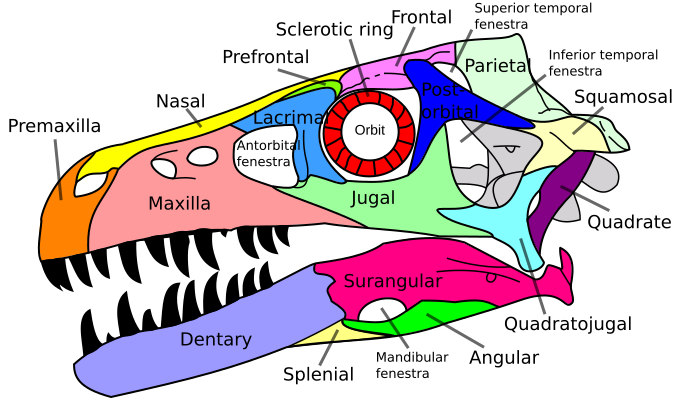

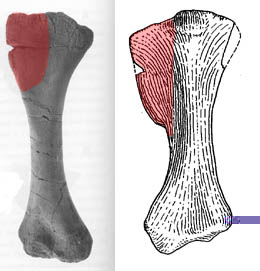
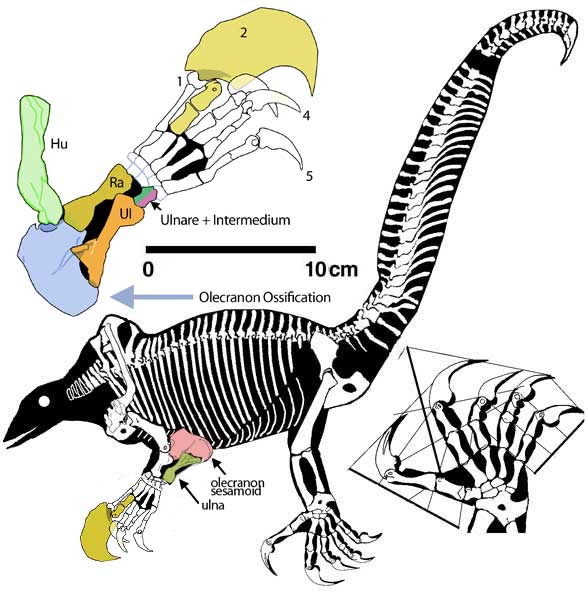
Nothing gets on my nerves more than someone labelling any and all prehistoric reptiles (and sometimes amphibians and even fish) as dinosaurs. There is a certain geological and map shop (or was - it's now closed down) that I pass quite regularly, that for a long time had a sign in the window that read: "For Sale: Dinosaur Teeth (Mosasaur) 100 Million Years Old". Now, average Joe Bloggs reading this is probably thinking: "What's so wrong with that?". The problem is, mosasaurs were NOT dinosaurs. And this blog post is going to attempt to show that by demonstrating what is a dinosaur and why.
Before I get to the crux of this discussion, I feel obliged to give you a crash-course in cladistics. Cladistics is the science of classification that groups organisms together based on the degree of "relatedness" (this is slightly different to taxonomy - more on that some other time). Anyway, there are three ways to define a clade (group). Node-based, stem-based and apomorphy-based.

Node-based definitions are along the lines of : A + B, their most recent common ancestor and all of its descendants. For example Dinosauria can be defined as "Passer (sparrow) + Triceratops, their most recent common ancestor and all of its descendants". So basically, a dinosaur is any organism that branched off the line leading to Triceratops after the branch that ultimately leads to Passer. Naturally, node-based definitions are less reliable because it relies on being quite confident about which groups are the most "primitive" and which are the most "advanced".
Stem-based definitions are similar, but more easy to understand. They are in the form of: Everything closer to A + B than to Z, to use these diagrams. So, for instance, a stem-based definition of Dinosaur would be: all Dinosauriformes (the next rank up from dinosaur) closer to Tyrannosaurus and Triceratops than to Lagerpeton (a potential dinosaur ancestor, however, this definition dates from 2004 and since then other, more dinosaur-like animals have been discovered like Silesaurus - add this to the long list of topics to cover in the future).
Finally, apomorphy-based definitions are the ones that are most easily understood by the layperson, but don't always reflect true, natural groups. Apomorphies are characteristics that are unique to a particular group (or rather a unique combination of features). It is this definition that I wish to further explore here.
OK, now that that's out of the way we can get to the fun stuff! First of all, there is no simple way of identifying a dinosaur. However, a few generalisations can be made. Firstly, they could not fly (sort of - the origin of flight in the whole dinosaur-into-bird thing hasn't been pinned down yet, but it seems likely that true flight evolved with the birds). This means that the pterosaurs (not pterodactlys - more on that some other time) are not dinosaurs. And yes, technically speaking, birds are dinosaurs, but just for the sake of convenience, I'm only going to be discussing traditional, non-avian dinosaurs. Secondly, dinosaurs were not fully aquatic (some evidence suggests that duck-billed dinosaurs were partly aquatic and it is presumed dinosaurs could swim). Therefore, plesiosaurs and ichthyosaurs were not dinosaurs either (and the next time I hear someone call the Loch Ness monster a dinosaur I will scream).
According to Michael J. Benton (2004), the unique characteristics of Dinosauria are:
- Loss of the prefrontal
- An elongate deltopectoral crest on the humerus
- A brevis shelf on the ventral surface of the postacetabular part of the ilium
- An extensively perforated acetabulum
- A tibia with a transversely expanded subrectangular distal end, as well as as caudolateral flange, a depression for the astragalus, and an ascending astragalar process on the cranial face
"What the Jiminy Cricket does that mean?!?!" I hear you cry. Well, I'm glad you asked Sunny Jim, because I'm going to explain all.
1. Loss of the prefrontal
The prefrontal is a bone in the skull just in front of the frontal (hence the name). Most dinosaurs, technically, did have a prefrontal, however, it was mostly fused to another bone, the lacrimal. Their descendants, the birds, have lost this bone completely. In the picture below, of Dromaeosaurus, the prefrontal is the lime green bone just in front of the eye, above the lacrimal. Notice how small it is.

In this picture of a python, however, the Prefrontal is labelled as C. It is a much larger bone in other reptiles.

2. An elongate deltopectoral crest on the humerus
All this means is that dinosaurs have a long crest or ridge running along the top bit of the thigh.

Compared to other reptiles, in this case Drepanosaurus (a prehistoric tree-climbing reptile that has defied every attempt to classify it), you can see the humerus marked Hu and in light green. (Sorry about the quality, it was the only picture of a non-dinosaurian reptile humerus I could find).

3. A brevis shelf on the ventral surface of postacetabular part of the ilium

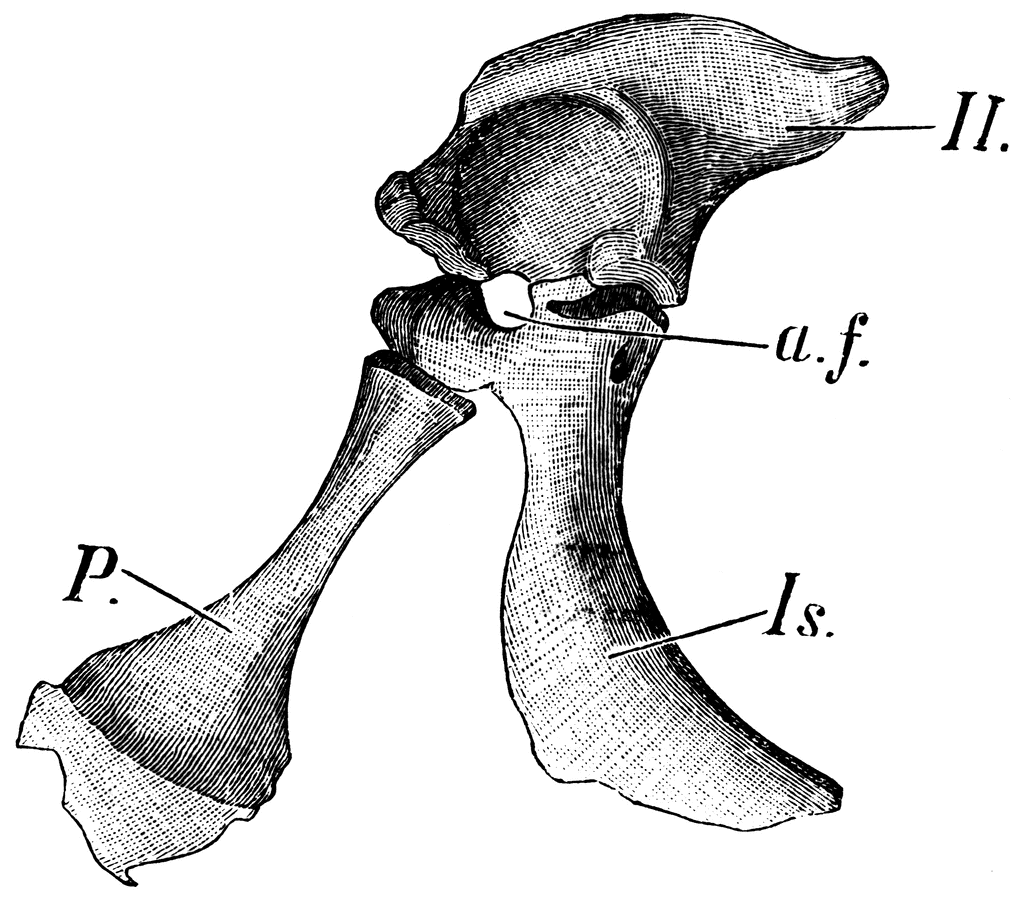
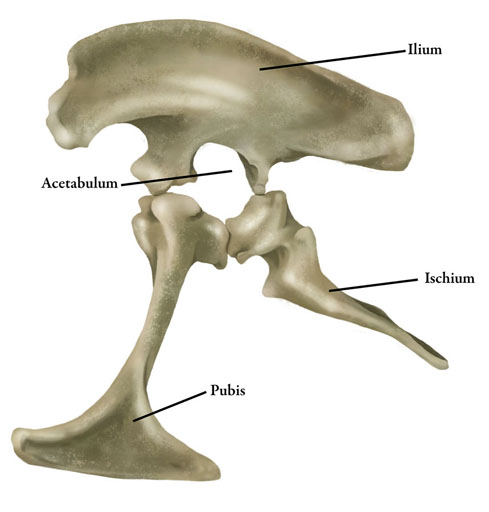 If you look at the crocodile hip image above, you'll notice that while there is a hole (the acetabular foramen) there is still a large furrow or socket where the femur connects to the hip.
If you look at the crocodile hip image above, you'll notice that while there is a hole (the acetabular foramen) there is still a large furrow or socket where the femur connects to the hip.
 It has a transversely expanded subrectangular distal end (which means the bottom part is stretched and is vaguely rectangle shaped), it has a caudolateral flange (which is a small ridge running along the bottom - not easy to see in this picture), a depression for the astragalus (which means it has a furrow at the bottom allowing the bone below (the astragalus) to connect to) and an ascending astragalar process on the cranial face which can be seen better in the image below - it's the part that looks like a triangle)
It has a transversely expanded subrectangular distal end (which means the bottom part is stretched and is vaguely rectangle shaped), it has a caudolateral flange (which is a small ridge running along the bottom - not easy to see in this picture), a depression for the astragalus (which means it has a furrow at the bottom allowing the bone below (the astragalus) to connect to) and an ascending astragalar process on the cranial face which can be seen better in the image below - it's the part that looks like a triangle)
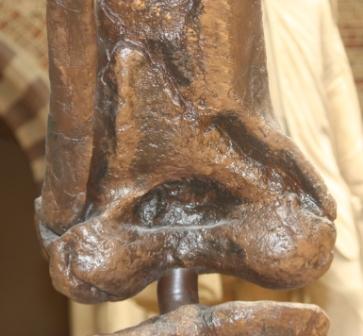
This means that, like the humerus, dinosaurs have a ridge on the bottom of the ilium (one of the hip bones), behind the acetabulum (the hip socket). On this diagram, the brevis shelf is marked bs.

Compared to this drawing of a crocodile's pelvis, the ilium (marked Il.) is much smoother and curved.

4. An extensively perforated acetabulum
What this means, simply, is that dinosaurs' hip sockets are actually holes rather than sockets.
 If you look at the crocodile hip image above, you'll notice that while there is a hole (the acetabular foramen) there is still a large furrow or socket where the femur connects to the hip.
If you look at the crocodile hip image above, you'll notice that while there is a hole (the acetabular foramen) there is still a large furrow or socket where the femur connects to the hip.
5. A tibia with a transversely expanded subrectangular distal end, as well as as caudolateral flange, a depression for the astragalus, and an ascending astragalar process on the cranial face
Let's have a look at a dinosaur's tibia, shall we?
 It has a transversely expanded subrectangular distal end (which means the bottom part is stretched and is vaguely rectangle shaped), it has a caudolateral flange (which is a small ridge running along the bottom - not easy to see in this picture), a depression for the astragalus (which means it has a furrow at the bottom allowing the bone below (the astragalus) to connect to) and an ascending astragalar process on the cranial face which can be seen better in the image below - it's the part that looks like a triangle)
It has a transversely expanded subrectangular distal end (which means the bottom part is stretched and is vaguely rectangle shaped), it has a caudolateral flange (which is a small ridge running along the bottom - not easy to see in this picture), a depression for the astragalus (which means it has a furrow at the bottom allowing the bone below (the astragalus) to connect to) and an ascending astragalar process on the cranial face which can be seen better in the image below - it's the part that looks like a triangle)
So that's that. If the fossil you are looking at exhibits all of these features then it is a dinosaur. For now. It hasn't always been like this. About 15-20 years ago, there were a lot of features in the ankle that were considered to be important. But now that we've found more crocodile ancestors, it seems that dinosaur ankles weren't that unique. Maybe in 10 years time, the definition will have changed but this will suffice for now.
I hope this has explained what a dinosaur is. In future, I hope to expand upon this, with more anatomy and with other groups. What's next? An article on my favourite dinosaur: Tyrannosaurus rex!
See also:
Other dinosaur posts
More dinosaur anatomy
More on dinosaur skulls
See also:
Other dinosaur posts
More dinosaur anatomy
More on dinosaur skulls
References
Benton, M. J. (2004) 'Origin and Relationships of Dinosauria', in, Weishampel, D. B., Dodson, P. and Osmólska, H. (eds) The Dinosauria (2nd Edition), London: University of California Press
Subscribe to:
Posts (Atom)






